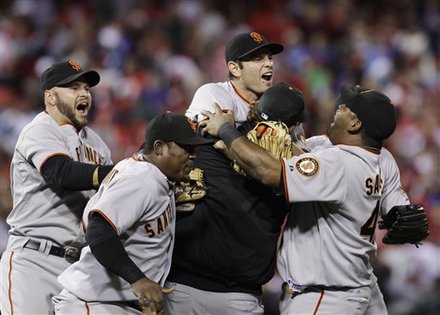 |
| The Giants celebrate their victory over the Phillies in Game 6 of the NLCS to win the NL Pennant |
![]() I don’t want to do this.
I don’t want to do this.
I mean, I really don’t want to do this. I put it off for a day, but I suppose I owe it to you all.
As a Phillies fan, nothing was more frustrating than the past week and a half. Watching a team that was built to win championship after championship play like the Phillies of 2000 (65-97) was agonizing.
The Giants’ offense–self-described as “torture”–looked more like your favorite slippers and a warm blanket when compared to that of the Phillies.
Yeah, it really was that bad.
Before I get too carried away, let’s look over the points discussed in the NLCS Preview.
The Rust Factor
The Phillies didn’t really show so much rust in Game 1. At least not looking back on it. At first, it may have appeared that way–Roy Halladay didn’t have his “A” game, and the offense sputtered and struggled to score. But as we reflect on the series as a whole, it wasn’t rust for the offense, and maybe, just maybe, the Giants were so well prepared that they were able to jump on every opportunity and mistake.
Coming Back
 |
| Cody Ross hurt the Phillies more than any other Giant in the NLCS |
Neither Pat Burrell, nor Aaron Rowand wound up doing much damage to the Phillies in their return to Philadelphia. Actually, both were quite ineffective. Burrell hit a measly .211 and knocked in just one run. Rowand started a couple of games and went 1-for-5 with a run scored. In the end, it wound up being another guy the Phillies were quite familiar with in Cody Ross that did the most damage.
Pitching, Pitching, Pitching
Well, we didn’t really see much in the way of pitchers’ duels, but we didn’t exactly see the scoreboards light up, either. This was a dirty series where most of the runs were scrapped together. No pitcher was truly dominant (aside from maybe Roy Oswalt in Game 2), but on the flip side, only Jonathan Sanchez really failed on the hill. In the end, pitching really didn’t determine this series. The offenses did, but not in the way I expected, either.
Playing a Clean Game
Here’s where the games were decided. Chase Utley played some poor defense all series. Placido Polanco drilled Buster Posey in the back on a throw to first. Shane Victorino couldn’t corral an over-the-shoulder catch at the wall. The Phillies offense, well, they couldn’t do anything right.
![]()
They had a horrible approach at the plate, swinging at bad breaking pitches and taking belt-high fastballs. And they had opportunities, they just didn’t take advantage of them. On the other side of the field, the Giants jumped on every bad pitch and made a point to get the runner home one way or another.
Not to take anything away from the Giants–they clearly wanted this more and played a damn good series–but the Phillies beat themselves first and foremost. A team with this much offensive talent should not finish a six game series with a triple slash line of .216/.314/.321. Note the last number. The Phillies are known for their home run power. Their postseason lineup slugged .449 in the regular season. Ouch.
 |
| Chase Utley and the Phillies position players couldn’t do anything right against the Giants, in the field or at the plate |
The Phillies couldn’t do anything right at the plate this series. They struckout 56 times while walking just 20. They left 45 runners on base (7.5/game) and hit just .178 (8-for-45) with runners in scoring position. Countless times they couldn’t drive a leadoff baserunner home. The only player who actually hit the baseball–Ryan Howard–finished without an RBI (and 12 K).
I’ll leave you with a rundown of some key players in the series.
Giants
- Cody Ross – .350, 3 HR, 5 RBI, 4 R, 2 BB/5 K
- Matt Cain – 1-0, 7 IP, 2 H, 0 R, 5 K/3 BB, 0.714 WHIP, 0.00 ERA
- Tim Lincecum – 1-1, 14.1 IP, 12 H, 5 ER, 16 K/4 BB, 1.116 WHIP, 3.14 ERA
- Brian Wilson – 1-0, 3 SV, 5 IP, 2 H, 0 ER, 7 K/2 BB, 0.800 WHIP, 0.00 ERA
Phillies
- Roy Oswalt – 1-1, 14.2 IP, 14 H, 3 ER, 14 K/3 BB, 1.159 WHIP, 1.84 ERA
- Carlos Ruiz – .167, 1 HR, 1 RBI, 2 R, 1 BB/7 K
- Chase Utley – .182, 1 RBI, 5 R, 4 BB/2 K
- Ryan Howard – .318, 0 RBI, 1 R, 3 BB/12
Read more MLB news on BleacherReport.com

